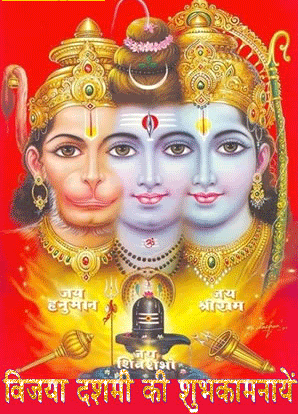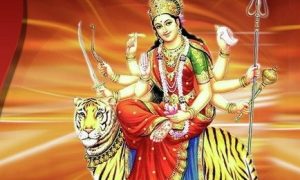History of Dussehra
Victory of Shri Rama over Ravan
Shri Ram, the seventh incarnation of Vishnu, killed the great demon Ravana who had kidnapped Mata Sita to Lanka. Shri Rama, his brother Lakshman, their follower Hanuman and an army of monkeys fought a battle to rescue Mata Sita.
Shri Ram, Mata Sita, and Lakshman returned to Ayodhya 0n the 14th day of the month of Kartik . To mark the return of Lord Ram, in the evening, the residents of Ayodhya lighted thousands of lamps (called Deepak). Since then, this day is celebrated Diwali or Deepawali.
During the ten days of Dasha-Hara, Deities of Ravana, his brother Kumbhakarna and son Meghanad are erected and burnt by enthusiastic youths at sunset.
After Dasha-Hara, the hot summer ends, especially in North India. The coming cold weather is believed to encourage infections. The burning of the effigies, filled with firecrackers containing phosphorous,it is suppose that purifies the environment while the Homa done at temples.
People perform Homa as a Shanti Yag and recite Sundara Kaand in these days.
Victory of Durga Mata over Mahishasur
Some of the demons, or Asuras, were very powerful and ambitious and continually tried to defeat the Devas, or Gods , and capture Heaven. One Asura, Mahishasur, in the form of a buffalo, grew very powerful and created havoc on the earth. Under his leadership, the Asuras defeated the Devas. The world was crushed under Mahishasura’s tyranny, the Devas joined their energies into Shakti, a single mass of incandescent energy, to kill Mahishasur.
A very powerful band of lightning emerged from the mouths of Brahma, Vishnu and Shiva and a young, beautiful female virgin with ten hands appeared. All the Gods gave their special weapons to her. This Shakti coalesced to form the goddess Durga. Riding on a lion, who assisted her, Durga fought Mahishasur. The battle raged for nine days and nights. Finally on the tenth day of Ashvin shukla paksha, Mahishasur was defeated and killed by Durga.
Hence Dasha-Hara is also known as Navaratra or Durgotsava and is a celebration of Durga’s victory. Durga, as Consort of Lord Shiva, represents two forms of female energy – one mild and protective and the other fierce and destructive.
Home Coming of Durga Mata
Daksha, the Lord of the Earth, and his wife Menaka, had a daughter called Sati. As a child, Sati started worshipping Lord Shiva as her would-be-husband. Lord Shiva was pleased with the Sati’s worship of him and married her. Daksha was against their marriage but could not prevent it. Daksha arranged a yagna to which everyone except Lord Shiva was invited. Sati, feeling ashamed of her father`s behaviour and shocked by the attitude meted towards her husband, killed herself. Lord Shiva was anguished when he discovered this. He lifted Sati’s body on his shoulders and started dancing madly. With the supreme power dancing with wrath, the World was on the verge of destruction.
Then Lord Narayana came forward as a saviour and used his Chakra to cut Sati`s body into pieces. Those pieces fell from the shoulders of the dancing Shiva and scattered throughout the world. Shiva was pacified when the last piece fell from his shoulder. Lord Narayana revived Sati. The places where the pieces of Sati fell are known as the Shakti Piths or energy pits. Kalighat in Kolkata, Kamakshya near Guwahati and Vaishnav Devi in Jammu are three of these places.
In her next birth, Sati was born as Parvati or Shaila-Putri (First form of Durga), the daughter of Himalaya. Lord Narayana asked Shiva to forgive Daksha. Ever since peace was restored, Durga, with her children Saraswati, Lakshmi, Kartikeya, Ganesh and her two `sakhis` – Jaya and Vijaya – visit her parents each year during the season of `Sharatkal` or autumn when Durga-Puja is celebrated.
End of Agnyatwas of Pandava
In the age of Dwapar Yuga, Pandava – the five acknowledged sons of Pandu (Sanskrit: पांडु), by his two wives Kunti and Madri – lost to Kauravas in a game of dice, and both spent twelve years of Vanawas, or exile to the forest, followed by one year of Agnyatawas. The brothers hid their weapons in a hole in a Shami tree before entering the Kingdom of Virat to complete the final year of Agnyatwas. After that year, on Vijayadashmi, they recovered the weapons, declared their true identities and defeated Kauravas, who had attacked King Virat to steal his cattle. Since that day, Shami trees and weapons have been worshipped and the exchange of Shami leaves on Vijayadashmi has been a symbol of good will and victory.
Kautsa’s Gurudakshina
Kautsa, the young son of a Brahmin called Devdatt, lived in the city of Paithan. After completing his education with Rishi Varatantu, he insisted on his guru accepting Guru Dakshina, a present. The guru said, “Kautsa, to give ‘dakshina’ in return for learning wisdom is not proper. Graduation of the disciple makes the guru happy, and this is the real Guru Dakshina.”
Kautsa was not satisfied. He still felt it was his duty to give his guru something. The guru said, “All right, if you insist on giving me dakshina, so give me 140 million gold coins, 10 million for each of the 14 sciences I have taught you.”
Kautsa went to King Raghu. Raghuraja was an ancestor of Lord Rama, famous for his generosity. But just at that time he had spent all his money on the Brahmins, after performing the Vishvajit sacrifice. King Raghu asked Kautsa to return three days. Raghuraja immediately left to get the gold coins from Indra. Indra summoned Kuber, the god of wealth. Indra told Kuber, “Make a rain of gold coins fall on the “Shanu” and “Aapati” trees round Raghuraja’s city of Ayodhya.”
The rain of gold coins began to fall. King Raghu gave all the coins to Kautsa, and Kautsa hastened to offer the coins to Varatantu Rishi. Guru had asked only 140 millions, so he gave the rest back to Kautsa. Kautsa was not interested in money, considering honour to be more valuable than wealth. He asked the king to take the remaining gold coins back. But the king refused, as kings do not take back the daan (gift).
Finally Kautsa distributed the gold coins to the people of Ayodhya on the day of Ashvin shukla dashami. In remembrance of this event, there has been a custom of looting the leaves of the Aapati trees, and people present these leaves to one another as gold.
Courtesy by wikipedia





Leave a Reply